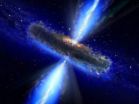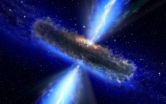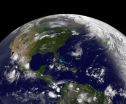(Press-News.org) PASADENA, Calif.—Water really is everywhere. Two teams of astronomers, each led by scientists at the California Institute of Technology (Caltech), have discovered the largest and farthest reservoir of water ever detected in the universe. Looking from a distance of 30 billion trillion miles away into a quasar—one of the brightest and most violent objects in the cosmos—the researchers have found a mass of water vapor that's at least 140 trillion times that of all the water in the world's oceans combined, and 100,000 times more massive than the sun.
Because the quasar is so far away, its light has taken 12 billion years to reach Earth. The observations therefore reveal a time when the universe was just 1.6 billion years old. "The environment around this quasar is unique in that it's producing this huge mass of water," says Matt Bradford, a scientist at NASA's Jet Propulsion Laboratory (JPL), and a visiting associate at Caltech. "It's another demonstration that water is pervasive throughout the universe, even at the very earliest times." Bradford leads one of two international teams of astronomers that have described their quasar findings in separate papers that have been accepted for publication in the Astrophysical Journal Letters.
A quasar is powered by an enormous black hole that is steadily consuming a surrounding disk of gas and dust; as it eats, the quasar spews out huge amounts of energy. Both groups of astronomers studied a particular quasar called APM 08279+5255, which harbors a black hole 20 billion times more massive than the sun and produces as much energy as a thousand trillion suns.
Since astronomers expected water vapor to be present even in the early universe, the discovery of water is not itself a surprise, Bradford says. There's water vapor in the Milky Way, although the total amount is 4,000 times less massive than in the quasar, as most of the Milky Way's water is frozen in the form of ice.
Nevertheless, water vapor is an important trace gas that reveals the nature of the quasar.
In this particular quasar, the water vapor is distributed around the black hole in a gaseous region spanning hundreds of light-years (a light-year is about six trillion miles), and its presence indicates that the gas is unusually warm and dense by astronomical standards. Although the gas is a chilly degrees Celsius ( degrees Fahrenheit) and is 300 trillion times less dense than Earth's atmosphere, it's still five times hotter and 10 to 100 times denser than what's typical in galaxies like the Milky Way.
The water vapor is just one of many kinds of gas that surround the quasar, and its presence indicates that the quasar is bathing the gas in both X-rays and infrared radiation. The interaction between the radiation and water vapor reveals properties of the gas and how the quasar influences it. For example, analyzing the water vapor shows how the radiation heats the rest of the gas. Furthermore, measurements of the water vapor and of other molecules, such as carbon monoxide, suggest that there is enough gas to feed the black hole until it grows to about six times its size. Whether this will happen is not clear, the astronomers say, since some of the gas may end up condensing into stars or may be ejected from the quasar.
Bradford's team made their observations starting in 2008, using an instrument called Z-Spec at the Caltech Submillimeter Observatory (CSO), a 10-meter telescope near the summit of Mauna Kea in Hawaii. Z-Spec is an extremely sensitive spectrograph, requiring temperatures cooled to within 0.06 degrees Celsius above absolute zero. The instrument measures light in a region of the electromagnetic spectrum called the millimeter band, which lies between infrared and microwave wavelengths. The researchers' discovery of water was possible only because Z-Spec's spectral coverage is 10 times larger than that of previous spectrometers operating at these wavelengths. The astronomers made follow-up observations with the Combined Array for Research in Millimeter-Wave Astronomy (CARMA), an array of radio dishes in the Inyo Mountains of Southern California.
This discovery highlights the benefits of observing in the millimeter and submillimeter wavelengths, the astronomers say. The field has developed rapidly over the last two to three decades, and to reach the full potential of this line of research, the astronomers—including the study authors—are now designing CCAT, a 25-meter telescope to be built in the Atacama Desert in Chile. CCAT will allow astronomers to discover some of the earliest galaxies in the universe. By measuring the presence of water and other important trace gases, astronomers can study the composition of these primordial galaxies.
The second group, led by Dariusz Lis, senior research associate in physics at Caltech and deputy director of the CSO, used the Plateau de Bure Interferometer in the French Alps to find water. In 2010, Lis's team was looking for traces of hydrogen fluoride in the spectrum of APM 08279+5255, but serendipitously detected a signal in the quasar's spectrum that indicated the presence of water. The signal was at a frequency corresponding to radiation that is emitted when water transitions from a higher energy state to a lower one. While Lis's team found just one signal at a single frequency, the wide bandwidth of Z-Spec enabled Bradford and his colleagues to discover water emission at many frequencies. These multiple water transitions allowed Bradford's team to determine the physical characteristics of the quasar's gas and the water's mass.
INFORMATION:
The other authors on Lis's paper, "Discovery of water vapor in the high-redshift quasar APM 08279+5255 at Z=3.91," are Tom Phillips, Caltech's John D. MacArthur Professor of Physics and director of the CSO; David Neufeld of Johns Hopkins University; Maryvonne Gerin of the Paris Observatory and the French National Center for Scientific Research; and Roberto Neri of the Institute of Millimeter Radio Astronomy in France. Funding was provided by the National Science Foundation (NSF).
The authors on Bradford's paper, "The water vapor spectrum of APM 08279+5255: X-ray heating and infrared pumping over hundreds of parsecs," include Caltech's Hien Nguyen, a visiting associate and lecturer in physics; Jamie Bock, senior faculty associate in physics and scientist at JPL; and Jonas Zmuidzinas, the Merle Kingsley Professor of Physics and chief technologist at JPL. The other authors are Alberto Bolatto of the University of Maryland, College Park; Philip Maloney, Jason Glenn, and Julia Kamenetzky of the University of Colorado, Boulder; James Aguirre, Roxana Lupu, and Kimberly Scott of the University of Pennsylvania; Hideo Matsuhara of the Institute of Space and Astronautical Science in Japan; Eric Murphy of the Carnegie Institution for Science; and Bret Naylor of JPL.
Funding for Z-Spec was provided by the NSF, NASA, the Research Corporation, and partner institutions. The CSO is operated by Caltech under contract from the NSF. CARMA was built and is operated by Caltech, UC Berkeley, the University of Maryland, College Park, the University of Illinois at Urbana-Champaign, and the University of Chicago. CARMA is funded by a combination of state and private sources, as well as the NSF and its University Radio Observatories program.
Written by Marcus Woo
Caltech-led astronomers discover the largest and most distant reservoir of water yet
2011-07-25
ELSE PRESS RELEASES FROM THIS DATE:
Penn: Nanoplasmonic 'whispering gallery' breaks emission time record in semiconductors
2011-07-25
PHILADELPHIA — Renaissance architects demonstrated their understanding of geometry and physics when they built whispering galleries into their cathedrals. These circular chambers were designed to amplify and direct sound waves so that, when standing in the right spot, a whisper could be heard from across the room. Now, scientists at the University of Pennsylvania have applied the same principle on the nanoscale to drastically reduce emission lifetime, a key property of semiconductors, which can lead to the development of new ultrafast photonic devices.
The research ...
Earliest watery black hole discovered
2011-07-25
Pasadena, CA— Water really is everywhere. A team of astronomers have found the largest and farthest reservoir of water ever detected in the universe—discovered in the central regions of a distant quasar. Quasars contain massive black holes that are steadily consuming a surrounding disk of gas and dust; as it eats, the quasar spews out huge amounts of energy. The energy from this particular quasar was released some 12 billion years ago, only 1.6 billion years after the Big Bang and long before most of the stars in the disk of our Milky Way galaxy began forming.
The research ...
Can feeling too good be bad? Positive emotion in bipolar disorder
2011-07-25
Positive emotions like joy and compassion are good for your mental and physical health, and help foster creativity and friendship. But people with bipolar disorder seem to have too much of a good thing. In a new article to be published in the August issue of Current Directions in Psychological Science, a journal of the Association for Psychological Science, psychologist June Gruber of Yale University considers how positive emotion may become negative in bipolar disorder.
One of the characteristics of bipolar disorder is the extreme periods of positive mood, or mania. ...
Farthest, largest water mass in universe discovered
2011-07-25
An international team of astronomers led by the California Institute of Technology and involving the University of Colorado Boulder has discovered the largest and farthest reservoir of water ever detected in the universe.
The distant quasar is one of the most powerful known objects in the universe and has an energy output of 1,000 trillion suns -- about 65,000 times that of the Milky Way galaxy. The quasar's power comes from matter spiraling into the central supermassive black hole, estimated at some 20 billion times the mass of our sun, said study leader Matt Bradford ...
Shining a light on the elusive 'blackbody' of energy research
2011-07-25
CHESTNUT HILL, MA (July 22, 2011) – A designer metamaterial has shown it can engineer emitted "blackbody" radiation with an efficiency beyond the natural limits imposed by the material's temperature, a team of researchers led by Boston College physicist Willie Padilla report in the current edition of Physical Review Letters.
A "blackbody" object represents a theorized ideal of performance for a material that perfectly absorbs all radiation to strike it and also emits energy based on the material's temperature. According to this blackbody law, the energy absorbed is equal ...
Life scientists use novel technique to produce genetic map for African Americans
2011-07-25
UCLA life scientists and colleagues have produced one of the first high-resolution genetic maps for African American populations. A genetic map reveals the precise locations across the genome where DNA from a person's father and mother have been stitched together through a biological process called "recombination." This process results in new genetic combinations that are then passed on to the person's children.
The new map will help disease geneticists working to map genetic diseases in African Americans because it provides a more accurate understanding of recombination ...
Cellular stress can induce yeast to promote prion formation
2011-07-25
It's a chicken and egg question. Where do the infectious protein particles called prions come from? Essentially clumps of misfolded proteins, prions cause neurodegenerative disorders, such as mad cow/Creutzfeld-Jakob disease, in humans and animals. Prions trigger the misfolding and aggregation of their properly folded protein counterparts, but they usually need some kind of "seed" to get started.
Biochemists at Emory University School of Medicine have identified a yeast protein called Lsb2 that can promote spontaneous prion formation. This unstable, short-lived protein ...
NASA catches 3 tropical cyclones at 1 time
2011-07-25
It's not often that a satellite can capture an image of more than one tropical cyclone, but the GOES-13 satellite managed to get 3 tropical cyclones in two ocean basins in one image today. Bret and his "sister" Cindy are racing through the North Atlantic, while another area tries to develop far to their south. "Cousin" Dora is still a hurricane in the eastern Pacific.
In infrared image taken on July 22 at 0845 UTC (4:45 a.m. EDT), GOES-13 captured Tropical Depression Bret, Tropical Storm Cindy in the north Atlantic and low pressure area associated with a tropical wave ...
Northwest Forest Plan has unintended benefit – carbon sequestration
2011-07-25
CORVALLIS, Ore. – The Northwest Forest Plan enacted in 1993 was designed to conserve old-growth forests and protect species such as the northern spotted owl, but researchers conclude in a new study that it had another powerful and unintended consequence – increased carbon sequestration on public lands.
When forest harvest levels fell 82 percent on public forest lands in the years after passage of this act, they became a significant carbon "sink" for the first time in decades, absorbing much more carbon from the atmosphere than they released. At the same time, private ...
New target found for nitric oxide's attack on salmonella bacteria
2011-07-25
A new target for nitric oxide has been revealed in studies of how it inhibits the growth of Salmonella. This bacterium is a common cause of food-poisoning.
"Nitric oxide is naturally produced in the nose and the gut and other tissues in the body to ward off infection," explained the senior author of the paper, Dr. Ferric Fang. He is a University of Washington (UW) professor of laboratory medicine, microbiology and medicine.
Nitric oxide – not to be confused with nitrous oxide, the laughing gas in dentists' offices – is similar to the preservatives in hotdogs, Fang ...




